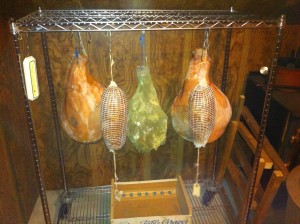So you want to make your own prosciutto? If all goes well, you’ll eventually be rewarded by ridiculously delicious cured ham. I’ve been told that it’s also really sexy and virile. If you screw up, you’ll have blown about 50$ and have to salvage what meat you can through putting it to stock. Potential mates will also snicker at you and you will lose your sexy and virile mystique. The lesson here folks is: don’t screw up.
To that end, here are some ground rules:
- Follow the recipe. At least the first time. Curing meat is easy but you probably aren’t used to it. As a result, if you go out on a limb and follow a hunch you may run into big trouble.
- Be patient. It takes time to prepare prosciutto. 2 days for bleeding, 10 days in a flavoured brine and at least 365 spent drying. If you cut anything short you will end up with a prosciutto that is either too wet or too dry.
- Don’t be afraid of mould. It’s a good sign, question yourself if none grows during the drying process.
- If something doesn’t smell right, stop, think and seek help. Recipes aren’t foolproof, not even this one. So many environmental factors come into play. You really need to keep an eye on your prosciutto throughout the process so if there is ever any rot (I haven’t seen any in years of following this recipe) you can try to salvage what is left of your prosciutto.
Now that you know the rules of the game, you’re ready to actually get out there and start curin’ some pork.
Choosing

Pork Leg and Salt : All you need to get started
The first step in making prosciutto is running out to buy a leg of pork. You’ll want to see a reputable butcher for this and ask him to round off the portion of the leg that connects to the pig’s torso (the lowest portion of the picture shown at the left of this paragraph). This will ensure that your prosciutto has a nice shape that’s easy for you to cut and deal with later. In Montreal, I usually go to Charcuterie Noel since they tend to get their meat from good suppliers and while waiting at the butcher’s counter I often see many pork legs go by, thus helping to ensure a healthy inventory turnover.
You’ll want to aim for a leg that is around 10-12 kilograms. Bigger legs give you bigger chunks that are ideal for slicing however once you get past 12 kilos the meat is generally tougher and not as desirable. Pork legs smaller than 10 kilos will often provide great testing and tender cured hams, but are less pleasant to slice.
One final note, if the butcher suggests removing the bone around the ball joint that connects to the pig’s hip, politely decline. Although many traditional recipes remove this bone before curing, this generally results in increased spoilage. Leaving it in will only make cutting the cured prosciutto more exciting. Yes… exciting….
Bleeding
Once you’ve got the meat on your kitchen counter, it’s time to start the curing process that turns this big hunk of pork into prosciutto. Before we begin, I’d like to bring up a topic from high school chemistry that is at the heart of this recipe: osmosis

Osmosis: Science at work
In order to cure meat, we’re going to need to dehydrate it. In order to dehydrate it and infuse it with the p roper flavours and rich colour we’re going to avoid using anything like those cheesy fruit dryers you see on infomercials. Instead, we’re going to use salt in high concentrations to cause liquid inside the prosciutto to come through a thin membrane of fat and muscle tissue and seep out. Thus, before we start gradually drying the meat in open air, we need to bleed and brine it to remove as much liquid as possible.
The first step in this process is to “bleed” the meat to remove part of the excess liquid in the pork. In this stage, we’ll be applying copious amounts of salt (about 600g) to a pork leg in order to start the curing process.
1. Liberally apply salt to the exposed muscle of the pork leg, ensuring that you work it into any nooks and crannies. Apply a less concentrated layer to the outer skin as well.

Thoroughly Salted Prosciutto
2. When salting all the crevices, pay special attention to this area. Ensure that you work salt in around the bone and on the meat underneath the skin.

Salted Crevice
Once you’ve applied salt to the pork leg, bring it to the cool, damp room you plan to eventually dry it in. Prepare a surface for the leg to lie flat on and some receptacle in which to collect the blood and any other oozings that will be extracted through osmosis. I do this by using a folding chair, which I cover with a plastic garbage bag for protection (I like my folding chairs).

First Day "Bleeding" Setup or "What 100lbs of Pork looks like"
With your surface prepared, place the pork leg skin down on the surface and use some object to prop it up at an angle to promote drainage of liquids onto the surface and into the receptacle you’ve positioned to catch the oozing. Leave it this way for 1 day.
On the second day, flip the prosciutto over and apply weight to it. Generally around 4-8 kilograms should suffice. Place the weights on the skin of the pork leg. Remember to keep the meat at an angle to promote drainage. Leave it this way for 1 day.
Once you’re done, continue through to my next post on the subject that shows you how to complete the curing process by preparing a flavourful brine.






